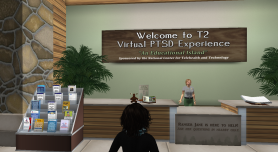 Earlier this month @DorleeM published an interview she did with me on Social Work Career Transition Blogger (a great blog for social workers, or those considering a career in social work). While the interview itself focused on social work career issues, the comments centered on virtual worlds. This post is excerpted from one of my comments:
Earlier this month @DorleeM published an interview she did with me on Social Work Career Transition Blogger (a great blog for social workers, or those considering a career in social work). While the interview itself focused on social work career issues, the comments centered on virtual worlds. This post is excerpted from one of my comments:
First Contact
I first joined a virtual world because of a client of mine. She was diagnosed with dissociative identity disorder and had a significant trauma history. As a result she sometime struggled with sorting out her perceptions of interactions and with interpersonal boundaries. She was really involved with Second Life and I didn’t have clue what that really meant–I had a sense that I needed to understand it to be able to help her sort out what was happening. So during our semester spring break I took the time to join Second Life.
I have to say that Second Life (SL) astonished me. I first just struggled with comprehending it. I consider myself pretty tech-savvy, but it was a few weeks before I could really get my brain around the idea of what it was. In retrospect I have to say that it was months before I really understood SL at a deep level.
Two things were, and are still, intriguing to me:
- the unlimited opportunity for creativity there: I walked on Mars, visited the NASA space museum, visited a virtual Van Gogh museum (where you can walk into the paintings), went scuba diving, I went through Virtual Hallucinations, a place where you experience what it might be like to have Schizophrenia (hear voices, experience the visual distortions)—users created those places. Beyond being a powerful medium for experiential learning, it also just became fun place to hang out, meet interesting people from all over the world, and do things together (the way you would in real life). As I explored the world, met some wonderful people there, including some that have become real life friends.
- The more interesting aspect for me related to avatars, identity, human relationships, and the nature of reality (simple things, LOL). Some examples:
- when another avatar would hug me, I–the me that was running the computer– would feel a sense of warmth and closeness. This intrigued me. Or in the middle of winter I would go to a beach in SL and listen to the waves and take in the sights–I was surprised how it provided a little reprieve from the snowy real world. Not as much as traveling there in real life, but more than I expected. As I thought about it more though I realized this made some sense–our brains processes images–that’s how we see. SL is images. The fact that these images aren’t “real” doesn’t mean they don’t affect me and have an emotional charge. After all, isn’t that all a movie is? images and sound?
- it was interesting to experiment with wearing different identities–you can change your look very easily–when I went as male, people related to me differently–they didn’t reach out as much and other men were more hostile. That observation, by the way, spawned an hour long conversation with a male friend in SL about what it means to be male in the real world and how men relate to each other with subtle non-verbals to tone down some of that hostility.
I really can’t do justice to all the ways in which identity comes into play and becomes fascinating to explore and understand. I had many long conversations about this, but I never got around to writing it down. The person who has done so is Botgirl (@Botgirlq). Here’s one interesting post from Botgirl’s Blog on The Continuum of Human Avatar Experience to give a flavor of the nuances of identity as they arise in virtual worlds.
Photo courtesy of Anna Levinzon









You must be logged in to post a comment.